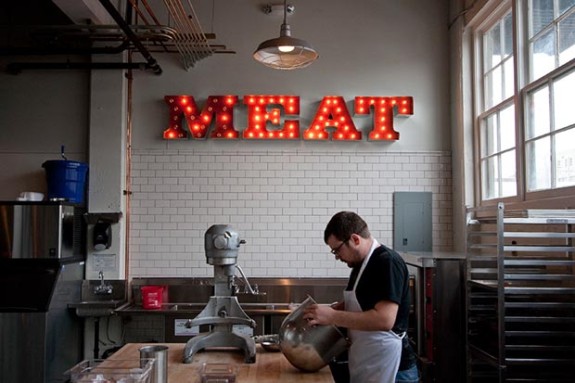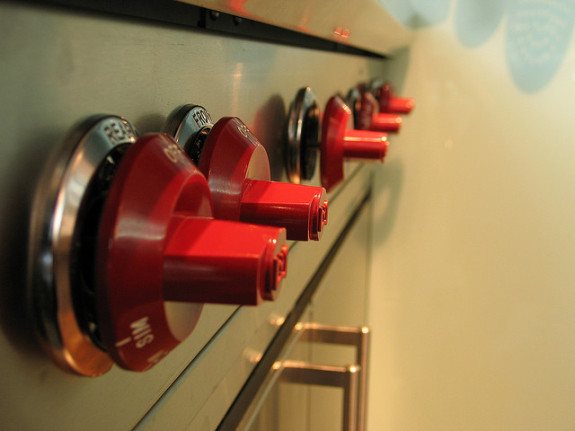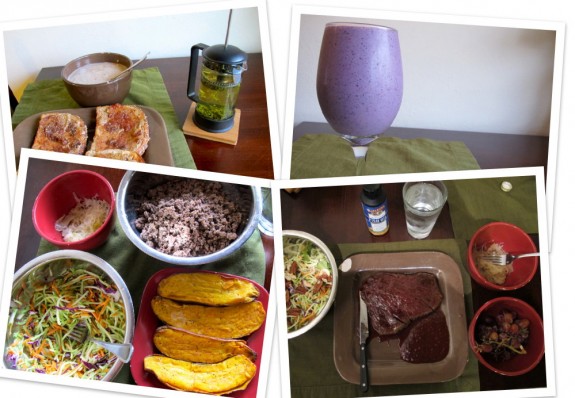How To Build Muscle On A Budget: 7 Nutrition Strategies
The former “Buffet Baron” shares 7 ways any guy can build muscle on a budget.
Back in college, my friends used to call me the Buffet Baron. The nickname sucked, but it was definitely on-point because I took the idea of “all you can eat” to ridiculous lengths.
As a guy trying to build a muscular, athletic body, I knew I needed to stock up on healthy food and supplements to make my time in the gym worth something.
The only problem? I was broke.
Enter the buffet.
I’d go to an “all you can eat” diner — the kind with rows of foods and a sneeze guard — and load up on meat, vegetables, and potatoes.
Then I’d go back for seconds. Then thirds.
Then I’d take out a small paper doggie bag and fill it with bread, chicken breasts, and random vegetables.
The contents of the doggie bag became my lunch for the next day, and I’d repeat the process.
I did this a couple times per week until restaurant management finally figured out they were getting fleeced.
Sadly, the Buffet Baron was no more.
Building Muscle On A Budget Requires Creativity
Now, I’m not necessarily proud of my Buffet Baron days — it probably walked the line of stealing — but it did show me how creative I could be when I only had a couple dollars to my name.
That need to be creative is something most guys overlook when they’re strapped for cash and trying to gain muscle. At least I’ve seen it with my own clients here in Scrawny To Brawny.
They want to build muscle and get stronger…but can barely afford the healthy food and supplements they need.
And it’s not only college kids.
Guys in between jobs, men who have families to support, or just guys who like to be frugal and spend their money consciously — they all wrestle with buying healthy food without breaking the bank.
I wrote this article for guys like that.
Since my days as the Buffet Baron, I’ve learned some more, ahem, appropriate strategies to build muscle without going broke, and I’d like to share them with you now.
Quick Note Before We Begin
Some of you will read this and say, “I know that already.” Or, “nothing new here.” To those guys, I have a challenge: go out and do at least one thing here that you’ve never done before.
After all, there’s a huge difference between knowing something and doing what you know. Just something to think about as you read.
7 Nutrition Strategies For Gaining Muscle On A Budget
1. Learn How (and Where) To Shop
Who says you have to buy your food at the closest grocery store to your house?
There are some uncommon places where you can pick up food at a surprisingly affordable price.
Farmer’s market – Everyone knows about farmer’s markets but almost no one gets up early enough to actually go to them.
Instead of sleeping in on Saturday, get your butt up and head to your closest one to stock up on cheap and local vegetables, fruits, and frozen meats. Bring cash.
Community-supported agriculture (CSA) – Each week you can get a box of seasonal produce, eggs, meat, cheese, homemade bread and other farm-raised/grown products delivered to your door.
Butcher shops – The rise of the supermarket brought an end to the local butcher shops. However, a growing disdain for the factory farm-raised meat available at grocery stores has allowed for the local butcher to make a comeback.
Local butcher shops offer quality, locally raised meat at reasonable rates. Their prices (especially on bulk) are sometimes even less expensive than the supermarkets.
How do you find a butcher shop? Easy. Go to Google. Type in “Butcher shop.” Click the “search” button.
 Guess what this shop sells.
Guess what this shop sells.
2. Buy in Bulk
Yeah, there’s more of an upfront cost to buying in bulk, but it will almost always save you money in the long run.
Wholesale membership clubs (Sam’s Club, Costco, etc.) will typically carry everything that a regular grocery store has, but the items are packaged in larger quantities at lower prices per serving.
The best foods to buy in bulk
- Oatmeal
- Rice
- Beans
- Dried fruit
- Beef jerky
- Nuts
- Meat (sometimes)
Buying meat in bulk isn’t always an option, especially if you don’t have a freezer large enough to store it.
But if you have the space, consider “cow-sharing”, where you purchase part of a live cow — usually a whole, half, or side — and pick up the meat once it’s processed.
This allows you to get delicious grass-fed meat at a $3-6 a pound instead of the of usual $7 or more per pound.
And it’s not just limited to beef.
You can also look for a local wild game processing shop where you can find deer, elk, antelope and other critters. If you live in the US, go to Eat Wild and click on your state to get started.
3. Get a Grocery DiscounT Card
If you consistently hit the same one or two grocery stores, make sure to sign up for a discount card (sometimes referred to as a loyalty card).
When swiped at the checkout stand, these cards will usually get you a small discount on your groceries. It may only be a dollar or two, but every little bit helps.
4. Learn to cook
I often hear guys complain about how they can’t afford to eat healthy because it costs too much. But after asking a few simple questions, I quickly learn that most of their meals are eaten at restaurants.
It’s been proven over and over again that cooking at home is healthier and less expensive than eating out or consuming pre-packaged meals.
The bottom line? Being able to cook for yourself is a skill that every man should have.
Check out The Reluctant Gourmet and the 4-Hour Chef to get started on basic skills.
 Knowing how to cook is a basic skill every man should have.
Knowing how to cook is a basic skill every man should have.
5. Cook The Same Meals Over and Over
It may sound boring, but eating the same meals over and over has two huge benefits:
1. You get to shop for all your ingredients in bulk. (Which saves you money.)
2. You become a master at cooking that meal. (Practice makes perfect.)
During his 28-day muscle-building experiment, S2B Program Director Nate Green ate the same thing every day, enabling him to gain 20 pounds of quality mass in less than a month. His sample “one day” menu is below.
One Day of Muscle Meals
BREAKFAST
- 2 frozen bananas, blended until creamy
- Small amount of almond milk
- 3 scoops of casein protein
- 2 squares of dark chocolate
- 4 pieces of whole grain bread
- 2 tbsp almond butter
- 2 tbsp jam
SUPER SHAKE
- 8 oz unsweetened almond milk
- 4 tbsp heavy whipping cream
- 2 scoops protein powder
- handful of frozen raspberries
- handful of frozen blueberries
LUNCH
- 1.5 pounds of lean meat
- 3 cups of vegetables
- 1/2 cup sauerkraut
- 2 large sweet potatoes
- 1 tbsp Udo’s oil
DINNER
- 1 pound lean meat
- 3 cups of vegetables
- 1/2 cup sauerkraut
- 2 pieces of fruit
- 1 tbsp fish oil
 A sample day of muscle-building meals.
A sample day of muscle-building meals.
6. Cook Tonight’s Dinner and Tomorrow’s Lunch at the Same Time
Just double the amount of food in the recipe, and save half of it for tomorrow. This works best with stir-fries.
7. Go over your monthly expenses and see what you can cut
Think of all the stuff you spend money on in your life: an unlimited cell phone plan, a new iPad, a cable bill, eating out, entertainment, clothes, alcohol, an extra car payment, etc.
How much do these things really contribute to your priorities and the overall quality of life you want to live?
Is there a way that you could reallocate some of the money spent on these items so you can buy better-quality food?
In the end, It all comes down to attitude
As you can probably tell by now, the whole idea of gaining muscle on a budget really comes down to your attitude regarding your financial situation.
In my experience, the guys who want it bad enough usually find a way to afford all of the food and supplements they need to build a better body.
Tips and strategies are great…but only when you’re ready to take action on them.
So which of the above 7 nutrition strategies are you gonna try next? (Personally, I’m thinking it’s about time to stock up on some venison…)
++++
Special Note: If you want a full grocery shopping list — along with specific muscle-building recipes — make sure to sign up for our 5-Day Free Course below. Day 2 of the course is dedicated to learning how to make the Ultimate Muscle Meal.
Free 5-Day Course Start Building a Muscular, Athletic Body Today

We’ll email you a link to Lesson 1 immediately. Then, each day for the next four days, you’ll get an email linking to a new lesson.
*Required. By providing your email, you agree to our
Terms & Conditions, Privacy Policy, and to receive email alerts
from Precision Nutrition. You can unsubscribe at anytime.
6 Responses to How To Build Muscle On A Budget: 7 Nutrition Strategies
-
Saying it’s too expensive to eat healthy is the #1 problem if you don’t know how to do it right. As I was reading this post I just kept agreeing to myself, did I write this? ha ha Great tips!
-
Actually I would expand #6 and prepare meals (either lunch or dinner) for the entire week in batch. It can be chili, post roast, chicken or something else where it’s obvious to divide up into portions (I like to use a food scale to make sure I get the portions equal).
While I like the idea of eating ‘wild’ or grass-fed meat, it is more expensive. My rule of thumb is to buy what’s on sale that week at the supermarket. This usually works out to about $2 to $3 a pound of chicken or beef. Yet I looked into that natural grass fed stuff and it’s at least twice as much. Definitely not for the budget minded. Is it worth paying twice as much for grass-fed. It can be,. OTOH, i’m not sure it’s safe to eat at least a can of tuna every day because it’s cheap.
-
I agree with you – cooking in larger quantities is great. If you plan ahead, you can cook 1-2 times per week and be set for most or all of your meals.
-
-
Sam’s Club and Costco are wonderful. At least at Sam’s, if you’re a college student, you can get a discounted membership. I believe mine was somewhere around $50, and they even gave me a $15 gift card as well. You can register 2 users on one account, and most stores don’t require the users to be related.
I know that some people think that the cost of the membership makes buying in bulk “not worth it,” but if you can share a membership or get a discounted one, it can really help out.
I have found that there are some items that are actually more expensive to buy in bulk at Sam’s (the specific items vary as prices change), so I try to price check at Walmart or a grocery store occasionally so I can try to spot those trends. -
Any suggestions on protein powder? What exactly am I looking for in the ingredients list and also avoiding? Is important to get only whey, casein, a blend, or does it matter?
BTW I enjoyed your article as always. However I still find that eating on the cheap is still too expensive for us. To give you an idea, our weekly budget for a family of five with young children is $80. I would guess that the example meals from the article were at least $3-4 which is inexpensive. But even in my family at $12-16 a day just for me to eat, all the budget would go to me.
But again thanks for the article.

Minor tweak: I like to cook tonight’s dinner and save the lunch for the day after tomorrow — just to avoid eating the same thing two days in a row. I do like variety. Thanks for the tips.